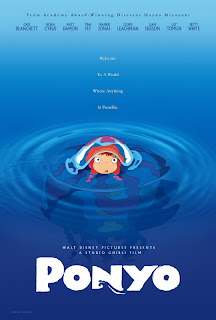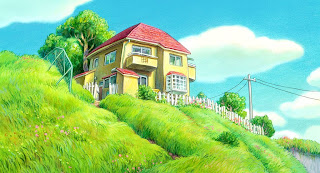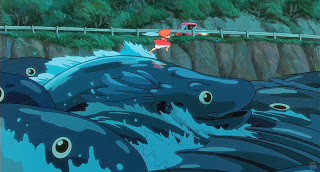
Animation is one of my favorite art forms to enjoy as a consumer of media. My favorite works of animation come from the realm of hand-drawn Japanese animation, and in particular the films of Academy-Award winning director Hayao Miyazaki. His most recent film Ponyo stands out to me as an imaginative and unique piece of animation. Miyazaki intended for this movie to appeal to small children and strove to see the world through their eyes, and he achieved this through both the narrative and animation styles. The background paintings look like scenes from a spectacular children’s storybook, with bright pastel colors and energetic strokes of (presumably) watercolor and colored pencils. The texture the animators achieved with mixed mediums is quite remarkable. Rocks and buildings in the scenery are rendered with playful curvature, using almost no straight lines, so that edges of buildings appear uneven and cliffs look rounded. The characters are drawn fairly simplistically but they have charming designs, colors, and personalities that fit seamlessly into the lively background paintings.


Elements of nature in the world of Ponyo take on new magical forms, especially Ponyo herself, who morphs between her fishy form and girl form. Furthermore, Ponyo in her “goldfish” form is not drawn literally like a fish, but more like how a little child might try to draw a fish: she has a face, a little tuft of hair, and her tail fin looks like a skirt. The look is both odd and delightful. In the film’s most acclaimed scene, even the waves of the ocean erupt into the form of giant blue fish and burst as they crash against the cliffs. The magical animation evokes the childlike curiosity of the main character, Sosuke, a five-year-old boy who lives by the sea. Sosuke stumbles upon Ponyo, a goldfish who gets stuck in a jar, and the two take a liking to each other, so Ponyo wants to become a human girl through the magic that is innate in her. It’s a slight and simple story about devotional love that unfolds on Miyazaki’s own terms, using a childlike “dream logic” rather than typical Hollywood-style story structure. In my mind, Ponyo is not about plot, it’s more about the subtext and the emotional impressions we (the viewers) experience in each scene. It’s an animated film that speaks to the kid in our hearts.


No comments:
Post a Comment